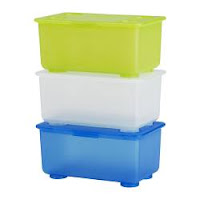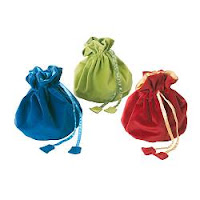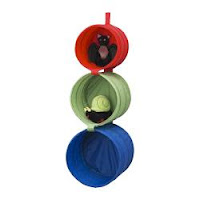Anyone who knows me will vouch for my ability to shop ’til I drop – not necessarily buying lots but always on the lookout for something new and exciting. And anyone who has been in one of my lessons, or attended a session I’ve led will also know that I love IKEA. My first outing after having #2 son was not to a restaurant, or even a pub, but late night shopping at IKEA. And, if you ignore the wardrobes, beds and sofas, and look at the smaller items, there are many things that can be used to inspire and facilitate PLL.
GLIS boxes are great for storing bits and bobs – and are different colours so allow for spontaneous questions: ¿Qué hay en la caja verde? ¿Los dados, las tijeras o las cartas? or instructions: Dame la caja azul por favor. Pon los dados en la caja blanca por favor.
Also good for storage are MINNEN velvet bags. I have a c ollection of these – I keep my finger puppets in one, and my paper puppets in another. I also use them for games such ¿Qué hay en la bolsa? – hide a number of small objects in the bag and children name an item by touch. I’ve recently done it with small farm animals and also fruit. Note to self – next time use plastic fruit to avoid a soggy bag smelling of strawberries! The element of wondering what’s in the bag adds to the exercise and keeps the class on its toes. It also allows for self differentiation as a child can pull out an item that they are pretty sure they know rather than be put on the spot.
ollection of these – I keep my finger puppets in one, and my paper puppets in another. I also use them for games such ¿Qué hay en la bolsa? – hide a number of small objects in the bag and children name an item by touch. I’ve recently done it with small farm animals and also fruit. Note to self – next time use plastic fruit to avoid a soggy bag smelling of strawberries! The element of wondering what’s in the bag adds to the exercise and keeps the class on its toes. It also allows for self differentiation as a child can pull out an item that they are pretty sure they know rather than be put on the spot.
 And finally on the storage front, NOJE storage boxes are collapsible so saves space – important at the best of times, but when your storage cupboard is the boot of your car, all the more vital – and, like the bags, have a use beyond the intended. I use mine for simple games.
And finally on the storage front, NOJE storage boxes are collapsible so saves space – important at the best of times, but when your storage cupboard is the boot of your car, all the more vital – and, like the bags, have a use beyond the intended. I use mine for simple games.
A favourite is throw the beanbag into the correct box. For the youngest children, I ask them to throw the beanbag into the same coloured box, reinforcing the colour vocabulary: el saco rojo en la caja roja. Then, to make it harder, I ask them to throw it into a different coloured basket: el saco azul en la caja verde. Teaches and reinforces colours as well as enhancing motor skills.
I also used them to separate food into ‘healthy’ – es bueno (green), ‘unhealthy’ – no es bueno (red) and ‘undecided’ – no sé (blue) The physical act of moving food adds movement to the lesson and was again tactile, reinforcing the groupings.
And you can play memory games too – ¿dónde está la manzana?
What about these UNDERBAR discs – my boys use them as frisbees although they are intended to be seat cushions. Why not use them as stepping stones, or for dancemat activities (they are textured so no danger of slipping) – both these activities allow sequencing and enhance memorisation skills.
When I ask questions, I like to throw things! I think it goes back to my early days of learning Span ish when my Colombian teacher had the habit of throwing someone’s pencil case around the room to keep us on our toes. It certainly did that, especially as it was a well packed case! Anyhow, the theory make sense to me although I prefer to avoid the danger of knocking out my pupils and so favour a small soft ball. I bought one from IKEA that contains a bell, so we could play with our eyes shut to work our auditory skills! I find it adds to the pace of the lesson, and pupils love being the teacher and getting to throw the ball. Recently, I got fed up of the ball and decided to go for something a bit more exciting – cue BÄSTIS! Actually dog toys, but I now own a pair of shoes
ish when my Colombian teacher had the habit of throwing someone’s pencil case around the room to keep us on our toes. It certainly did that, especially as it was a well packed case! Anyhow, the theory make sense to me although I prefer to avoid the danger of knocking out my pupils and so favour a small soft ball. I bought one from IKEA that contains a bell, so we could play with our eyes shut to work our auditory skills! I find it adds to the pace of the lesson, and pupils love being the teacher and getting to throw the ball. Recently, I got fed up of the ball and decided to go for something a bit more exciting – cue BÄSTIS! Actually dog toys, but I now own a pair of shoes
(trainers) that fly around the room. I wanted the pink boots but was informed by #1 son that they were not aerodynamic enough and #2 son that they are too girly!
That’s just the start of my IKEA inspired ideas – the best comes in the next post! Back in an hour or so :o)







